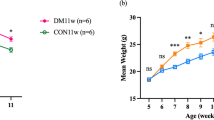Abstract
Submandibular gland responses to sympathetic and parasympathetic nerve stimulation were studied in streptozotocin-diabetic rats. Morphologically, the acinar cells in control glands were relatively uniform in size and contained electron-lucent granules. The granular ducts were distinguished by the presence of electron-dense granules. With the exception of intracellular lipid droplets and the presence of a few autophagosomes in diabetic glands, no consistent differences in acinar cell structure were observed. In contrast, the diameter of the granular ducts and the granule content of their cells were less in diabetic glands. At 3 weeks sympathetic flow rate, salivary protein concentration, and total protein output were unaffected by diabetes. Sympathetic flow rate was greater at 3 months, and the concentration of protein in the saliva was lower. In 6-month diabetic rats flow rate remained increased, but protein concentration and total protein output were reduced. The decrease in salivary protein concentration at 3 and 6 months was accompanied by a reduction in secretory granule release from acinar and granular duct cells. No consistent differences in flow rate, protein concentration, protein output, or secretory granule release were observed following parasympathetic stimulation. We conclude that the effects of diabetes on nerve-stimulated flow rate and protein release depend on the duration of diabetes and the type of stimulation, and are independent of one another.
Similar content being viewed by others
References
Abe K, Dawes C (1978) The effects of electrical and pharmacological stimulation on the types of protein secreted by rat parotid and submandibular glands. Arch Oral Biol 23:367–372
Ahern WA, Dunhill MS (1982) Morphometry. Arnold, London
Anderson LC (1983) Effects of alloxan diabetes and insulin in vivo on the rat parotid gland. Am J Physiol 245:G431-G437
Anderson LC, Garrett JR (1986) Lipid accumulation in the major salivary glands of streptozotocin-diabetic rats. Arch Oral Biol 31:469–475
Anderson LC, Suleiman AH (1989) Effects of streptozotocin-induced diabetes on sympathetically evoked submandibular salivary secretion in anaesthetized rats. J Physiol 418:98P
Anderson LC, Garrett JR, Proctor GB (1988) Advantages of burst stimulation for inducing sympathetic salivary secretion in rats. Q J Exp Physiol 73:1025–1028
Anderson LC, Garrett JR, Thulin A, Proctor GB (1989) Effects of streptozotocin-induced diabetes on sympathetic and parasympathetic stimulation of parotid salivary gland function in rats. Diabetes 38:1381–1389
Anderson LC, Garrett JR, Proctor GB (1990) Morphological effects of sympathetic nerve stimulation on rat parotid glands 3–4 weeks after the induction of streptozotocin-diabetes. Arch Oral Biol 35:829–838
Anderson LC, Garrett JR, Suleiman AH (1992) Secretory oedema in diabetic submandibular glands during parasympathetic nerve stimulation: relationship to microvascular abnormalities in streptozotocin-treated rats. Comp Biochem Physiol [A] 103:145–149
Arneberg T (1974) Quantitative determination of protein in saliva: a comparison of anlytical methods. Scand J Dent Res 79:60–64
Bogart BI, Picarelli J (1978) Agonist-induced secretions and potassium release from rat submandibular gland slices. Am J Physiol 235:C256-C268
Cutler LS, Pinney HE, Christian C, Russotto SB (1979) Ultrastructural studies of the rat submandibular gland in streptozotocin induced diabetes mellitus. Virchows Arch [A] 382:301–311
Ekström J, Mansson B, Tobin G (1987) Non-adrenergic non-cholinergic parasympathetic secretion in the rat submaxillary and sublingual glands. Toxicol Pharmacol 60:284–287
Garrett JR, Suleiman AM, Anderson LC, Proctor GB (1991) Secretory responses in granular ducts and acini of submandibular glands in vivo to parasympathetic and sympathetic nerve stimulation in rats. Cell Tissue Res 264:117–126
Hand AR, Weiss RE (1984) Effects of streptozotocin-induced diabetes on the rat parotid gland. Lab Invest 51:429–440
High AS, Sutton J, Hopper AH (1985) A morphometric study of submadibular salivary gland changes in streptozotocin-induced diabetic rats. Arch Oral Biol 30:667–671
Jaffa AA, Pratt J, Ashford A, Bailey GS (1984a) A time-course study of submandibular kallikrein, blood glucose and insulin of alloxan-diabetic and streptozotocin-diabetic rats. Agents Actions 15:478–481
Jaffa A, Rashid Z, Pratt J, Ashford A, Bailey GS (1984b) A quantitative study of the levels of glandular kallikrein in normal and diabetic rats. Biochem Med 31:42–46
Karnovsky MJ (1965) A formaldehyde-glutaraldehyde fixative of high osmolality for use in electron microscopy. J Cell Biol 27:137–138A
Liu FTY, Lin HS (1969a) Relationship between insulin and growth hormone in growth and development of rat submandibular glands. Proc Soc Exp Biol Med 131:175–179
Liu FTY, Lin HS (1969b) Role of insulin in body growth and the growth of salivary and endocrine glands in rats. J Dent Res 48:559–567
Murray FT, Orth J, Gunsalus G, Weisz J, Li JB, Jefferson LS, Musto N, Bardin CW (1981) The pituitary-testicular axis in the streptozotocin diabetic male rat: evidence for gonadotroph, Sertoli cell and Leydig cell dysfunction. Int J Androl 4:265–280
Quissell DO, Watson E, Dowd FJ (1992) Signal transduction mechanisms involved in salivary gland regulated exocytosis. Crit Rev Oral Biol Med 3:83–107
Rickkinen PJ, Niemi M (1968) Androgen-dependent salivary gland protease in the rat. Endocrinology 83:1224–1231
Reutervig CO, Hagg E, Henriksson R, Holm J (1986) Salivary glands in long-term alloxan-diabetic rats: a quantitative light and electron microscopic study. Acta Pathol Microbiol Immunol Scand 95A:131–136
Shafer WG, Muhler JC (1960) Endocrine influences upon the salivary glands. Ann NY Acad Sci 85:215–227
Takai N, Uchihashi K, Yoshida Y, Kakudo Y (1983) Salivational and histological damage of submandibular and sublingual glands in streptozotocin-induced diabetic rats. J Osaka Dent Univ 17:65–72
Tamarin A, Sreebny LM (1965) The rat submaxillary salivary gland: a correlative study by light and electron microscopy. J Morphol 117:295–352
Author information
Authors and Affiliations
Rights and permissions
About this article
Cite this article
Anderson, L.C., Garrett, J.R., Suleiman, A.H. et al. In vivo secretory responses of submandibular glands in streptozotocin-diabetic rats to sympathetic and parasympathetic nerve stimulation. Cell Tissue Res 274, 559–566 (1993). https://doi.org/10.1007/BF00314554
Received:
Accepted:
Issue Date:
DOI: https://doi.org/10.1007/BF00314554




